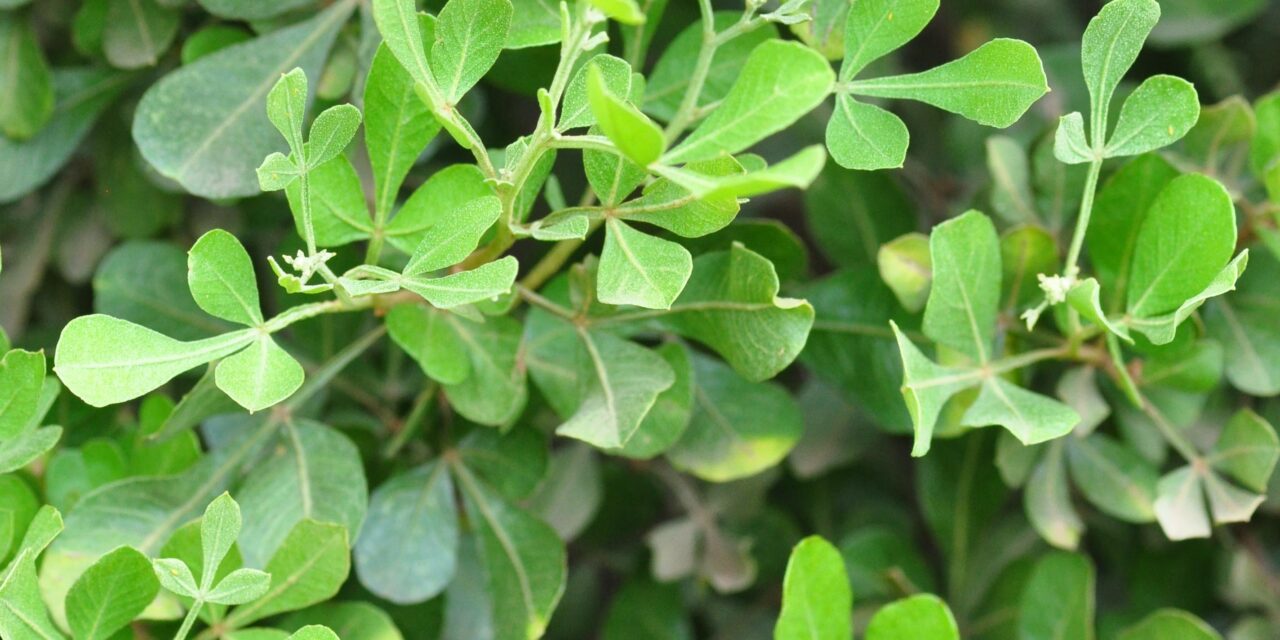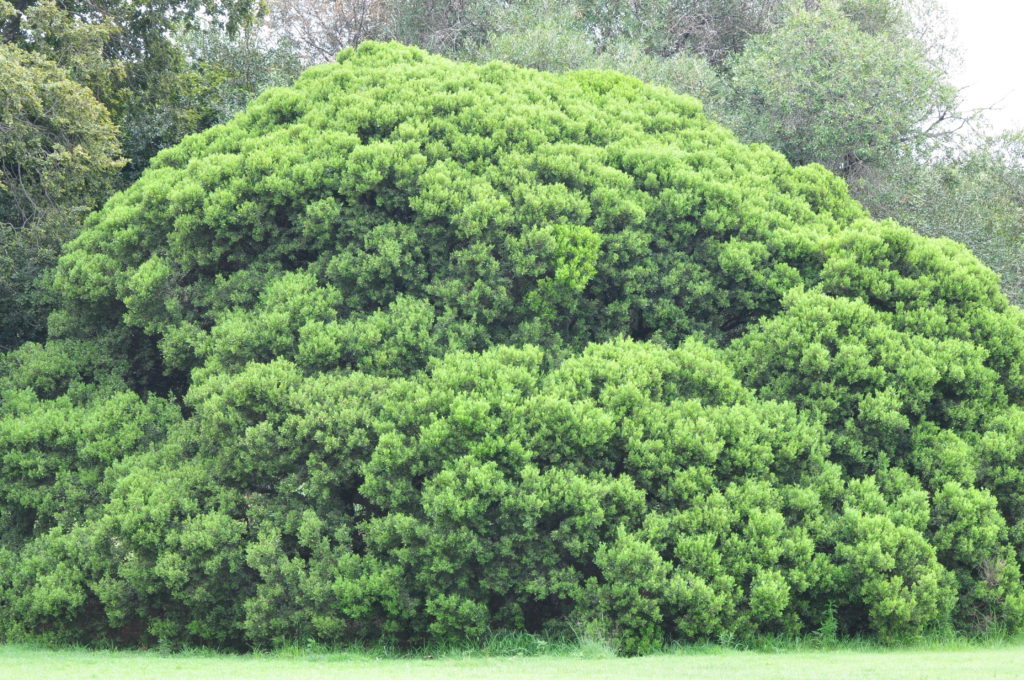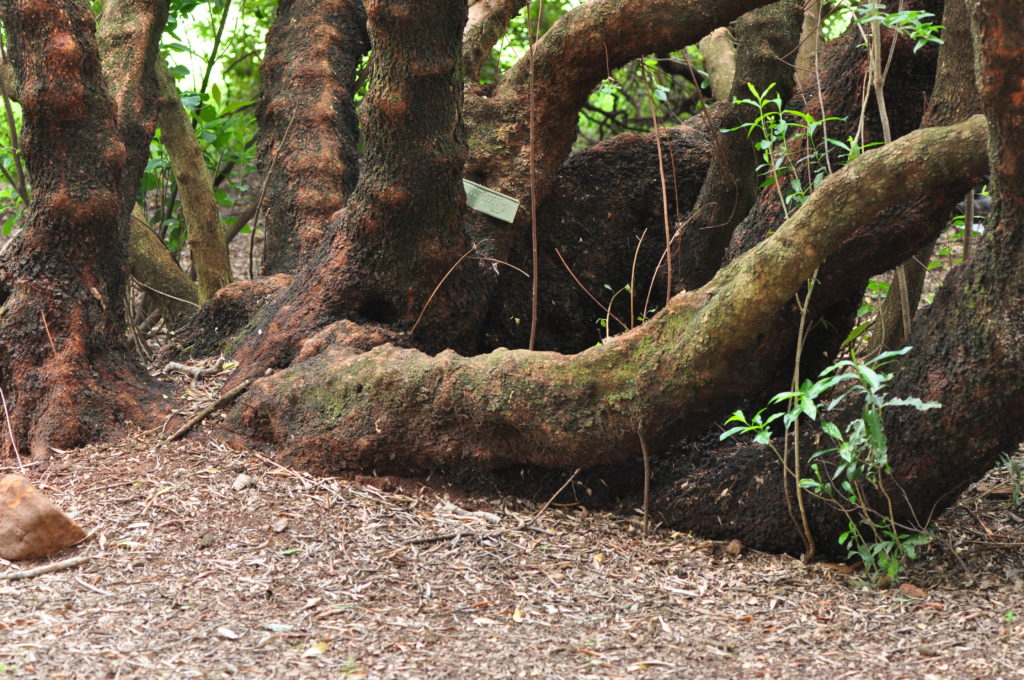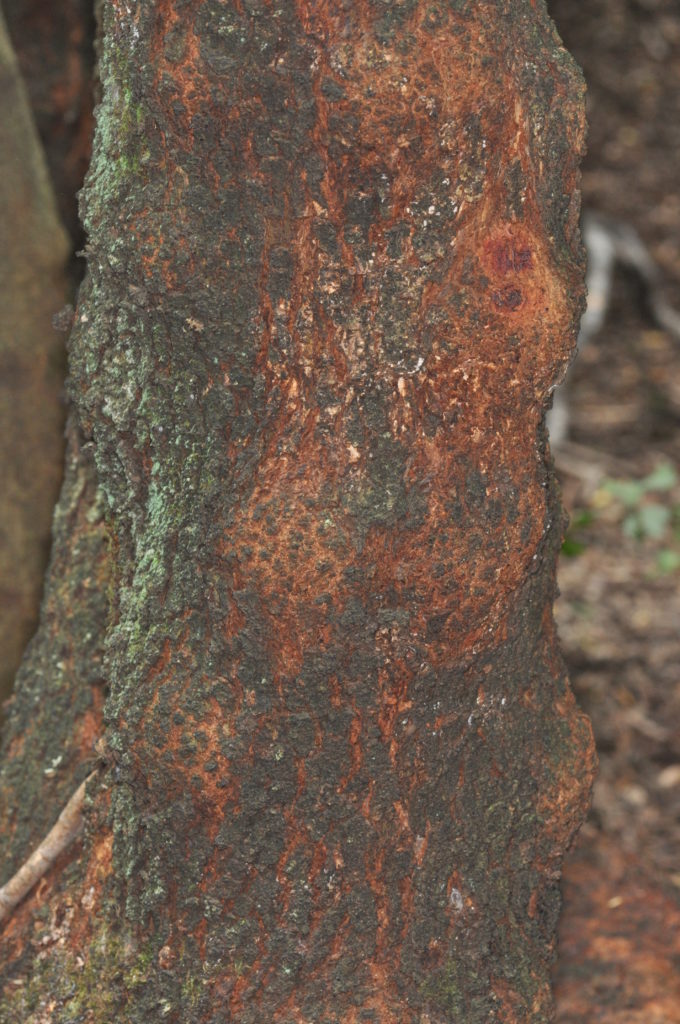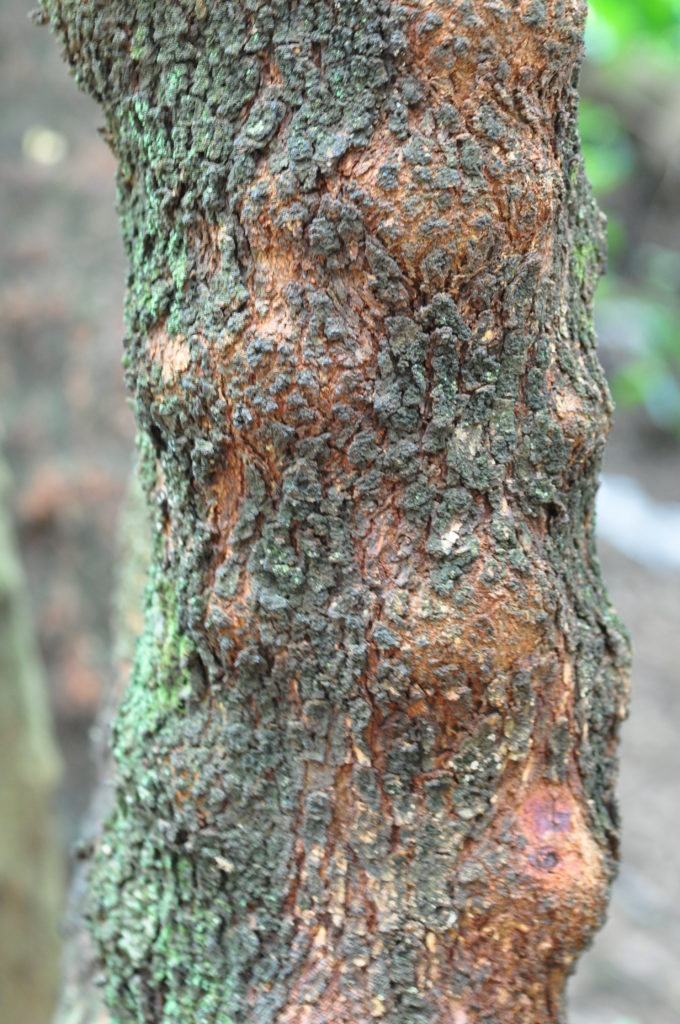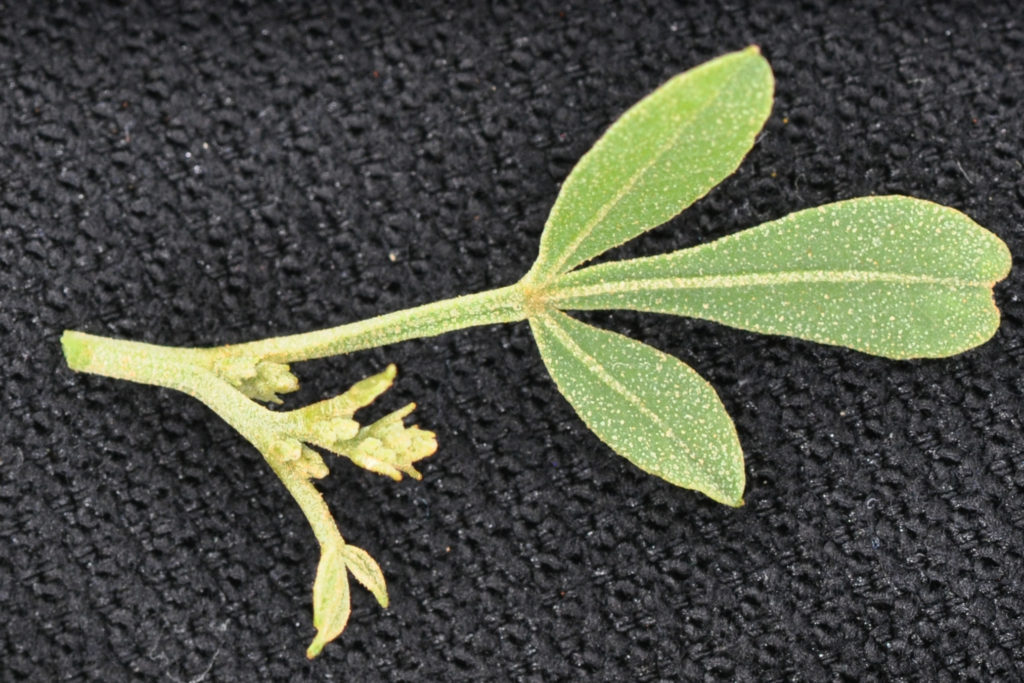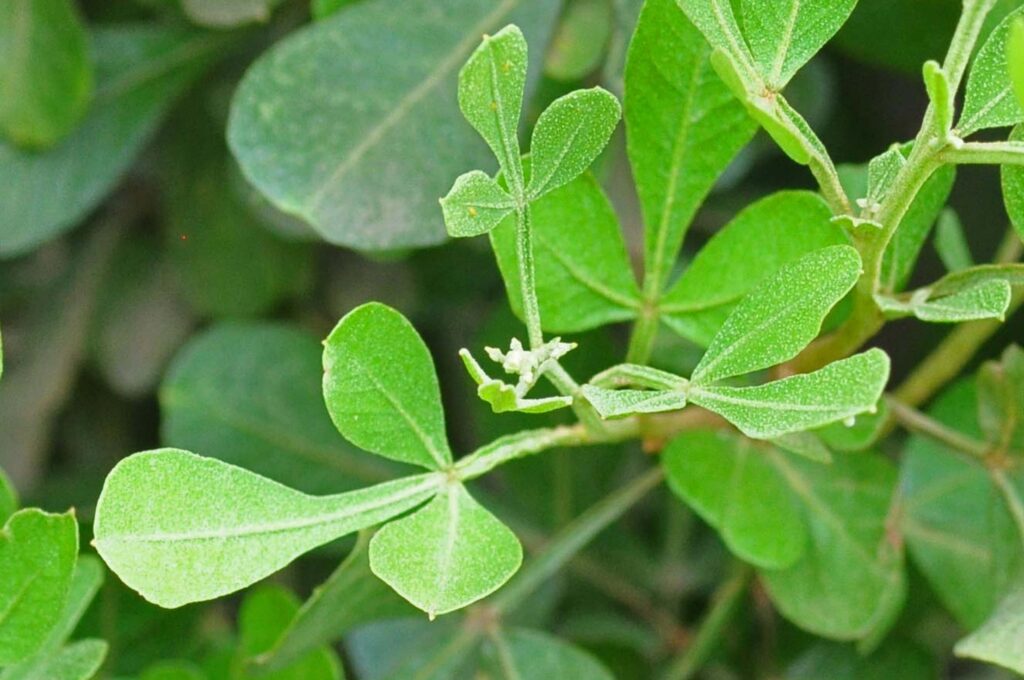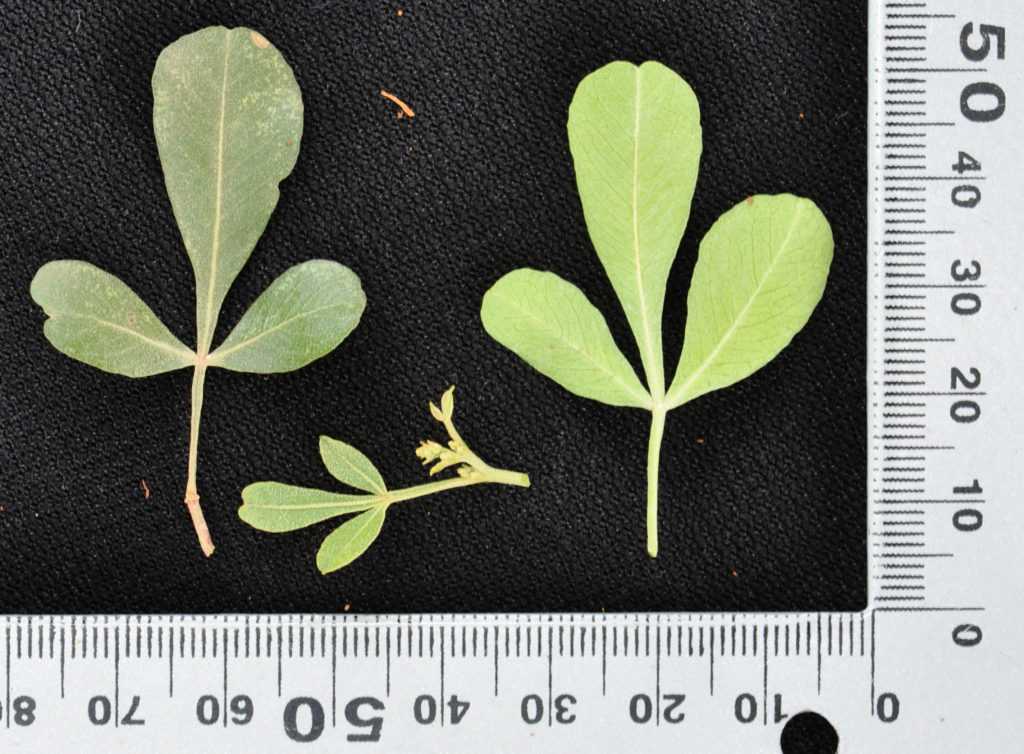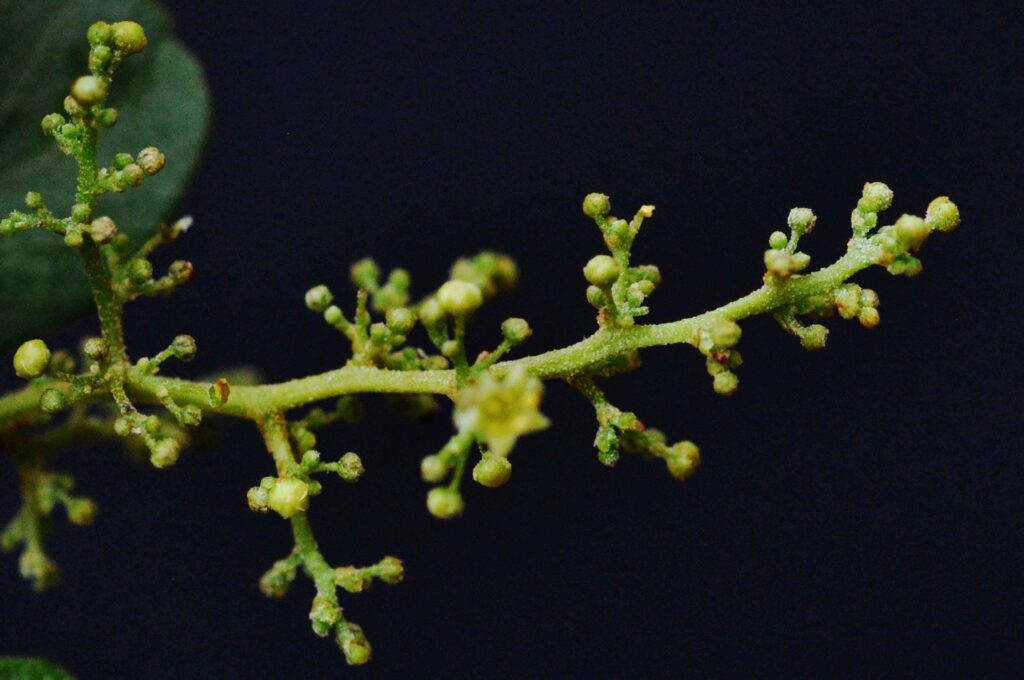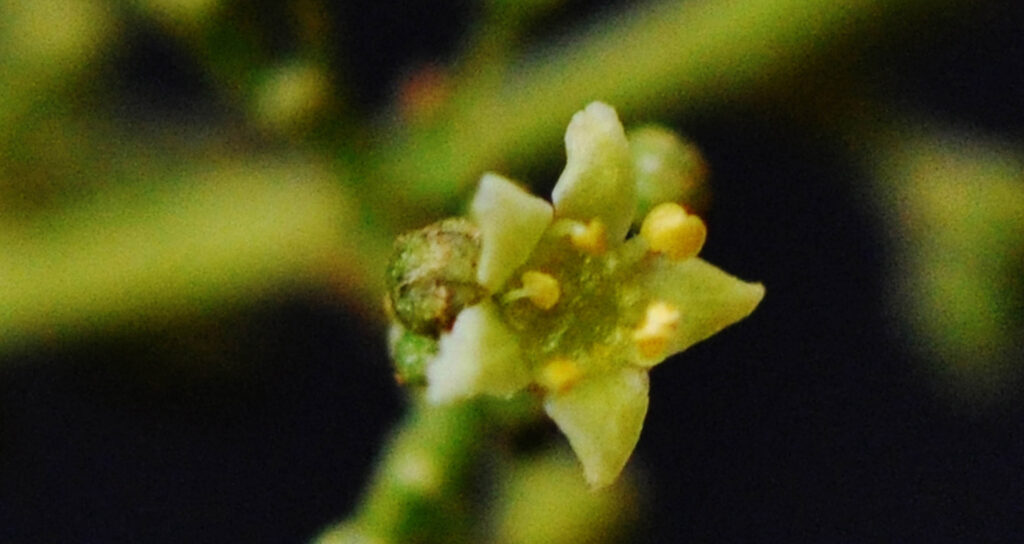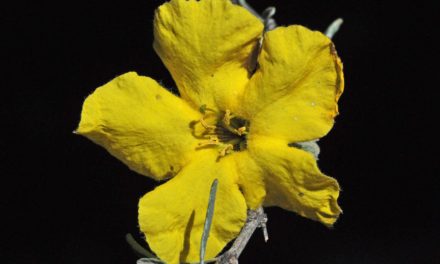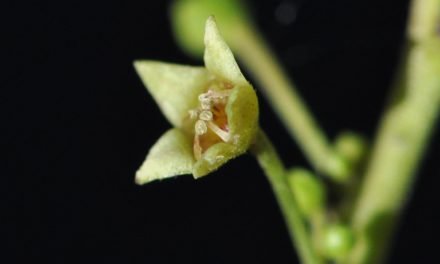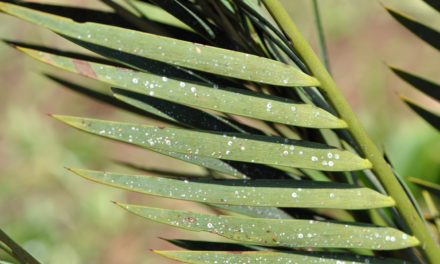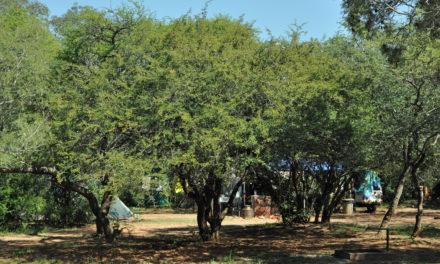General Info
This small Tree has divaricating branches and may reach 4m high. It is often a shrub. Trifoliate, olive green, small Leaves lack petiolules. Small obovate/oblanceolate leaflets are not rolled under. Minute, dioecious, greenish yellow, regular, 5-merous Flowers are in panicles. Male has 5 anthers. Female has 1 pistil, a superior ovary & 3 styles. Fruit is a small, almost spherical drupe containing one reniform seed.
Description
Searsia undulata
Previous Names: Rhus undulata var. celastroides, Rhus undulata var. genuine, Rhus undulata var. genuina forma contracta, Rhus undulata var. genuina forma excise, Rhus undulata var. genuine forma undulata, Rhus undulata var. undulata, Rhus undulata var. undulata forma contracta, Rhus undulata var. undulata forma excisa.
SA Tree No. 389.
Common names: (Afr) Koeniebos. (Eng) Kuni-bush, Namaqua Kuni-bush. Kuni-bush (applied to those species with obovate leaflets, wavy margins and a waxy surface).
Family: Anacardiaceae. (Mango family), which has about 83 genera and 850+ species – including Cashew). About 80 species occur in South Africa. Hunting arrows have been made from straight stems. Resin canals are present and woolly stellate hairs cover all young parts. Leaves lack stipules. They may be deciduous or evergreen and usually alternate. Leaves are simple, trifoliate or digitally compound and imparipinnate. Leaflets are usually opposite. Crushed leaves may smell of turpentine. Trees are monoecious or dioecious with occasional bisexual Flowers. Flowers are small, greenish or yellowish white and usually regular. The Calyx has 4-7 sepals and there are 4-7 Petals. The number of Stamens is the same as, or twice the number of petals and the Anthers are versatile. The superior Ovary has up to 4 locules, each with a single ovule. The 1-5 Styles are free or connate and separated at the base. Fruit is usually an indehiscent fleshy drupe. They provide food in dry areas. They contain a single quick growing Seed. The southern Africa genera containing trees on this website include Harpephyllum, Lannea, Loxostylis, Ozoroa, Sclerocarya and Searsia.
Name derivation: Searsia: Named after Paul Bigelow Sears a highly qualified American ecologist (1891 – 1990). He pioneered the study of fossil pollen in the USA. undulata – referring to the wavy margin. There are about 75 species of Searsia in southern Africa. There is most impressive specimen of Searsia undulata at the Pretoria National Botanical Garden (photos under Tree). All of the many Searsia species in South Africa have edible fruit that is rich in carbohydrates.
Conservation: National Status: LC. (Least Concern). Assessed: 2018 (L. von Staden).
Tree
This plant is usually a shrub. The Tree has many divaricate (spreading very far apart; extremely divergent; to branch at a wide angle) Branches and may have many stems, which often start almost horizontally and may collectively, or individually, reach 4m high (photo 242). Branchlets are angular and may be ribbed. The grey-brown Bark is smooth and may be glandular. In older plants, bulges may be present on the trunk (photos 241 & 244). Here the underlying reddish bark can be seen (photos 245 & 244).
- 242 2016.01.26 Pretoria NBG. Photo: David Becking.
- 241 2016.01.26 Pretoria NBG. Photo: David Becking.
- 245 2016.01.26 Pretoria NBG. Photo: David Becking.
- 244 2016.01.26 Pretoria NBG. Photo: David Becking.
Leaves
On this evergreen tree, the relatively small (photo 246) – up to 5 x 2cm Leaves are trifoliate (compound leaf with 3 leaflets). The Blade has lateral veins that are parallel and may be visible on both surfaces. The olive green, sticky Leaflets may be shiny and have pellucid (clear, almost transparent in transmitted light) veins. Leaves are membranous and aromatic when crushed. Leaflets are oblanceolate (the reverse of lanceolate, as leaf is broader at the apical third than at the middle and tapering towards the base) to obovate (egg-shaped – with the narrower end at the base – photo 246). Each leaflet has a central vein that protrudes on both surfaces (photo 246) and the upper surface may be waxy. The Petiole (stalk of leaf) is up to 2,5cm long and may be winged (photo 243). The central leaflet is the largest. Petiolules (stalk of leaflets) are absent (photo 248). The wavy, either entire or slightly toothed Margin is not rolled under and often wavy. The Bases are attenuate (showing a long, gradual taper). The Apex is retuse (having a rounded or obtuse apex with a central shallow notch – photo 248) or blunt or even sharp tipped (photo 243).
- 248 2016.01.26 Pretoria NBG. Photo: David Becking.
- 243RR 2016.01.26 Pretoria NBG. Photo: David Becking.
- 246 2016.01.26 Pretoria NBG. Photo: David Becking.
Flowers
The minute, greenish-yellow Flowers occur in hanging Panicles (indeterminate, branched inflorescence with stalked flowers – photo 104). Flowers are either in axillary or terminal positions. Individual flowers are actinomorphic (Regular, symmetrical. Flowers are vertically divisible into similar halves by more than 1 plane passing through the axis). The Male panicle is up to 10cm long (photo 104). Male flowers have 5 Stamens (photo 106). Here each free Filament has an Anther with 2 Thecae (pollen sacs) that dehisce longitudinally. Male flowers lack an ovary, but a rudimentary pistil is present. The Female or occasionally hermaphrodite panicles are shorter and less branched. Here each flower has a single Pistil (a unit of the Gynoecium, the female element of the flower, composed of the Ovary, Style and Stigma). The superior ovary has 3 free Styles present and each small Stigma is capitate (formed like a head). (Jan-May).
- 104 2017.12.26 Pretoria NBG. Photo: David Becking.
- Pret106 2017.12.26 Pretoria NBG. Photo: David Becking.oria NBG.
Fruit
The small, shiny, dull yellow to cream, thinly fleshy, hairless Fruit is a slightly compressed and almost spherical Drupe (a fleshy, 1-seeded indehiscent fruit with the seed enclosed in a stony endocarp; stone fruit – like a tiny peach) which is up to 6 x 7mm. Seeds are reniform (kidney shaped) and lack endosperm (the starch and oil-containing tissue of many seeds; often referred to as the albumen). (Mar-Jun).
Distribution & Ecology
These plants are only Located in the dry Western Cape – as far South as Ladysmith, Northern Cape and southern Namibia. They are thus endemic in Southern Africa (endemic – restricted to a particular geographic location). They often occur in deep mountain kloofs as well as semi desert areas like the Karoo (common characteristics include cloudless skies, low rainfall, dry air, and extremes of heat and cold. Here xerophytic spaced apart plants are the norm. The Silver Arrowhead (Phasis thero) butterfly is endemic in southern Africa. Their larvae occur on the stems and they feed on these Leaves. The Lighted Candles Mistletoe (Moquiniella rubra) – is a hemi-parasite (a plant which obtains or may obtain part of its food by parasitism). This hemi-parasite is only located in the Cape Province and Namibia and often grows on Searsia undulata. These and some other mistletoes belong to the family Loranthaceae (showy mistletoes) with their haustoria (root-like structures) absorbing mainly water from the host. This particular hemi-parasite may also occur on species of “Acacia” (Senegalia and Vachellia), Euclea, Ficus, Grewia, Searsea, Diospyros and Salix species.
Ethnobotany
Traditional medicine makes use of this plant. Bows are still made from the branches. Other trees used to make bows include Ziziphus mucronata, Olea Africana and Tarchonanthus camphoratus and Grewia species.
References
Coates Palgrave, M. 2002. Keith Coates Palgrave Trees of Southern Africa, edn 3. Struik, Cape Town.
Lawrence, G. H. M, 1951. Taxonomy of Vascular Plants. The Macmillan Company, New York. Tenth Printing 1965.
Palmer, E. & Pitman, N. 1972. Trees of southern Africa. Balkema, Amsterdam, Cape Town.
van Wyk, B. & van Wyk, P. 1997 Field guide to Trees of Southern Africa, Struik, Cape Town.
von Staden, L. 2018. Searsia undulata (Jacq.) T.S.Yi, A.J.Mill. & J.Wen. National Assessment: Red List of South African Plants version 2020.1. Accessed on 2023/12/11.
Woodhall, S. 2020. Field Guide to Butterflies of South Africa, edn 2. Donnelley, RR, China.
kyffhauser.co.za/Plants1/Searsia_undulata/Index.htm
https://plants.jstor.org/compilation/Moquiniella.rubra
https://en.wikipedia.org/wiki/Paul_Sears

